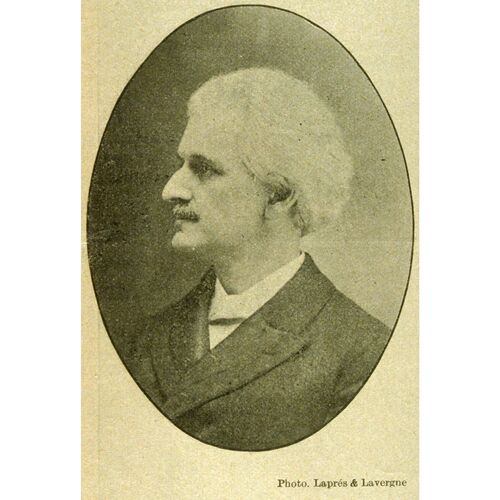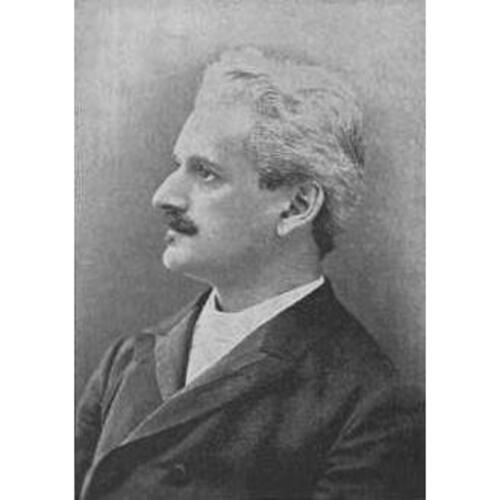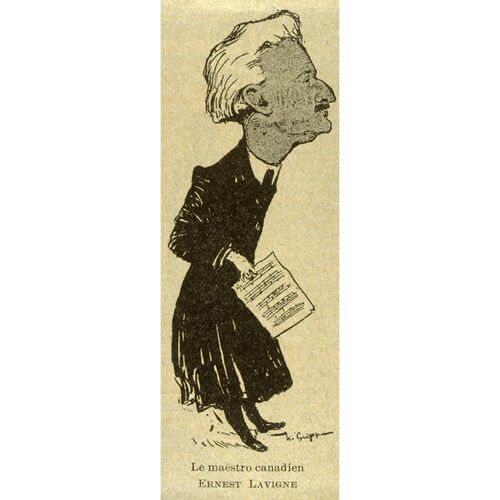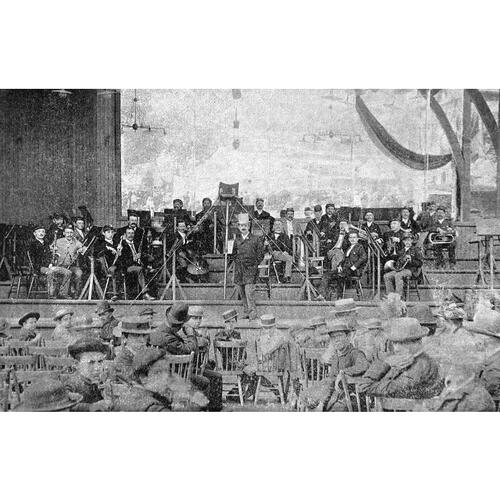As part of the funding agreement between the Dictionary of Canadian Biography and the Canadian Museum of History, we invite readers to take part in a short survey.
LAVIGNE (Tessier, dit Lavigne), ERNEST, Papal Zouave, musician, impresario, and businessman; b. 17 Dec. 1851 in Montreal, son of Moyse Tessier, dit Lavigne, a butcher, and Flore David; m. 26 Sept. 1876 in L’Islet-sur-Mer, Que., Marie-Louise Pouliot (d. 16 Dec. 1941 in Paris at 86), and they had four children, Juliette, Paul, Mario, and Ernestine; d. 18 Jan. 1909 in Montreal.
Two biographical notes published during Ernest Lavigne’s lifetime indicate that he attended the school of the Frères de la Doctrine Chrétienne in Montreal and completed his education with private teachers. His father was strongly opposed to the cultivation of his musical talent (and that of his brothers Jean-Moïse-Arthur* and Horace-Émery); as a result it was only later that he took up and studied music, apparently on his own.
In the summer of 1868 Lavigne left for Rome with the fourth detachment of Papal Zouaves. Within a few months he joined the Zouaves’ 60-member band and was chosen, as first cornet (and already a master of his instrument), to perform in an orchestra of 20 that was invited to play at musical evenings in the homes of Duchess Salviati and Princess Altieri. He left Rome for Naples at the end of September 1870 without having taken part in the fighting between Italian and papal forces. The next year he began a long journey that took him from Italy to Spain, Portugal, France, England, Denmark, and Norway. In 1873 he crossed the Atlantic to New York and played in Philadelphia and Boston.
Lavigne’s Canadian career began late in 1874. He spent more than a year with his brother Jean-Moïse-Arthur, who had a music store at Quebec. It may have been there that he became familiar with the business of selling music and first learned about the process of printing it. In addition, on the basis of his experience in the Zouaves he organized bands in the Quebec parishes of St Patrick and Saint-Roch, as well as in Sainte-Foy, L’Ancienne-Lorette, Saint-Joseph-de-Lévis (Saint-Joseph-de-la-Pointe-de-Lévy), Saint-Henri-de-Lauzon, and other places on the south shore of the St Lawrence down to Saint-Germain-de-Rimouski (Rimouski). Shortly after his marriage in September 1876, he spent two months in Philadelphia and then went back to New York, probably to perform as a cornet virtuoso.
Within a few months of his return to Montreal in 1877, Lavigne would reach an important point in his career. He was offered the position of conductor of the Musique de la Cité, which played for the 65th Battalion of Rifles (Mount Royal Rifles) and would acquire an enviable reputation under the familiar names of Bande de la Cité or Montreal City Band. This “excellent band” participated in a number of competitions under Lavigne’s baton between 1878 (a Canadian band competition held at the Victoria Skating Club of Montreal in May) and 1890 (a competition between the Gilmore Band of New York and the Montreal City Band, held at the same location on 2 June); it won all the honours and earned the esteem of Montrealers. Lavigne made the most of the successes by inaugurating free open-air concerts at the city’s Jardin Viger in the summer of 1879. Ten years later the band moved from amateur to professional status. As a result, 27 of the 55 members had to leave its ranks. Lavigne replaced them that year with musicians from the United States (17), Belgium (5), England (3), Italy (1), and France ( 1 ). The following year 30 performers of different nationalities, including 12 Belgians, 6 Frenchmen, and 2 Americans, joined the Montreal City Band. The “mixtures of performers” represented an approach different from that taken by his contemporary Guillaume Couture*: between 1894 and 1899, entire American orchestras were hired for the concerts of the Montreal Philharmonic Society, which Couture conducted. Using “mixtures” apparently had the results Lavigne anticipated, since he was able to present two concerts a day and offer a constantly changing program.
Lavigne’s band had turned professional immediately after the opening on 1 June 1889 of Parc Sohmer. Parc Sohmer is the name of a property that was rented, and then purchased in April 1890 from Hugh Taylor, by Lavigne and Louis-Joseph Lajoie, who were co-owners from 1881 to 1891 of a music store on Rue Notre-Dame in Montreal and who had the exclusive agency for Sohmer pianos, made by a New York company of that name. The park, which was an extremely popular Montreal entertainment spot, occupied a quadrilateral bounded by three streets, Panet, de Salaberry, and Notre-Dame, and the bluffs running along the St Lawrence (the present-day Jardin Guilbault). Responding to popular demand, Lavigne and Lajoie erected an arched wooden pavilion that had an orchestra pit, a 1,000-seat balcony, 15 boxes, and a main floor with a capacity of 6,000 to 8,000 seats. This building – which burned down on 24 March 1919 – made it possible to extend the Sunday concert season over the whole year.
The opening ceremonies took place on 13 May 1891, coinciding with a great festival held in aid of Notre-Dame Hospital from the 13th to the 15th. For this occasion Lavigne replaced the Montreal City Band with the Orchestre du Conservatoire, a symphonic ensemble of 44 professional musicians, most of them from the Conservatoire Royal in Liège, Belgium. But it probably was not as successful as had been expected, since the following year he reverted to having a wind ensemble of 30 to 40 musicians who were known from then on as the Bande (or Musique) du Parc and the Bande de Lavigne. The powerful and richly coloured tone typical of this group was certainly better suited to the location. Lavigne remained conductor until July 1908; he would be followed by Herbert Spencer*, Xavier Larose, Joseph-Jean Goulet*, and Peter Van der Meerschen.
The programming, oriented from the beginning towards concerts, relied increasingly on guests, such as the famous Canadian singer Emma Albani [Louise-Cécile-Emma Lajeunesse*] in 1890, and on “things everyone enjoys seeing and hearing” – light musical numbers and variety. This mix was especially the pattern in the years after the founding on 27 Jan. 1892 of the Montreal Zoological Garden, a corporation established by Lavigne, Lajoie, and five others. The dilettanti were not overlooked, however: in 1898–99, for example, Lavigne brought the Frenchman Louis Vérande to direct scenes from operas and operettas; in 1907 he turned to “modern” music, with scores by such composers as Mendelssohn, Gounod, Wagner, Saint-Saëns, Massenet, Delibes, Tchaikovsky, and Gomes, thus competing in boldness (though belatedly) with Couture.
The crowd of thousands who joined Lavigne’s funeral procession in Montreal on 21 Jan. 1909 bore witness to the extraordinary sympathy the people of the city felt for this “legendary personality.” His elegant appearance, his impeccable attire, his urbanity, his extraordinary musical intuition, his great renown, and his magnetic personality explain, according to those who knew him, the adulation he received. But the deep impression this musician and born organizer made upon the citizenry can only be understood in the light of the special place he had held for more than 20 years in the entertainment world. As the industrialization of Montreal proceeded apace at the turn of the century, Lavigne was able to introduce and develop in the east end a type of entertainment suited to the needs and means of the greatest number: the café-concert and the amusement park. These were then in vogue in the large cities of Europe and the United States, which he had visited more than once. In Parc Sohmer thousands found relaxation and enjoyment every day throughout the summer and, from 1891, every Sunday of the year as well. Lavigne was in some sense the moving spirit behind the park. Guillaume Couture, meanwhile, was enjoying a qualified success as conductor of the Montreal Philharmonic Society (1880–99), the Montreal Symphony Orchestra (1894–96), and the Montreal Amateur Operatic Club (1892–98), whose ever serious productions were aimed at the largely English-speaking élite of Montreal society.
Lavigne’s constant search for quality and for the novel and interesting explains why Montrealers supported his productions so faithfully. Thanks to his enterprising spirit, and also to his wide acquaintance with musical circles, Lavigne managed to put together a full orchestra (superior to any in North America, it was said), something hitherto impossible because of a shortage of competent instrumentalists. Although he did not have it for long, in all likelihood the reason was its incompatibility with the location chosen for the concerts. However, his initial effort gave rise to a musical tradition whose first performers included violinists Jean-Julien Clossey and Joseph-Jean Goulet, cellist Jean-Baptiste Dubois, bass player and trumpeter Adolphe Dubois, oboist Léon Kaster, clarinetists Jean Goulet and Jacques Vanpoucke, bassoonist Bartholemeus Gérôme, and timpanist Liévin Schepens, all Belgian musicians whom Lavigne had persuaded to join his Orchestre du Conservatoire and who moved to Montreal, where they were to play a leading role as teachers and performers of music.
As a composer, Lavigne holds a special place in the history of Canadian music. His output consisted entirely of songs and includes the largest group of Canadian works for solo voice and piano accompaniment composed in his time. The distinctive characteristics of his works are more evident when they are compared with pieces of the same genre written by his compatriot and contemporary Alexis Contant*. Lavigne’s output of 81 pieces was more than twice Contant’s 35. Contant’s works ranged from love songs to more serious melodies, with hymns, pieces written for special occasions, and patriotic songs. But Lavigne confined himself, with one exception (“Vive la France!”), to sentimental love songs. His choice of poets, mainly French, shows his fine taste; the same quality of lyrics is not always to be found in the works of Contant, who more often used the works of local poets. Musically speaking, Lavigne’s style is strikingly homogeneous: attention is concentrated solely on the melody, with its simple but highly tuneful line always in keeping with the metre; each work is in the appropriate mood and his artistry in composition allowed for little affectation or studied elegance. In these various respects the melodies of Contant are, as a whole, much more complex. It is still possible to be charmed by Lavigne’s love songs, so full of youth, love, and spirit, so unpretentious, to borrow the expressions used by Louvigny de Montigny* in describing the collection 25 songs, which was published in 1901. Although Lavigne’s pieces did not always achieve the profundity of Contant’s best compositions, at least they had none of the popular and conventional tone of the commercial jingles that ensured the success of the “concerts” performed during the early decades of the 20th century at the Ouimetoscope, the Nationoscope, or the National Theatre, the main entertainment centres competing with Parc Sohmer.
In 1949 Arthur Laurendeau, a former student of Guillaume Couture, reckoned that Ernest Lavigne would be no more remembered than a meteor fallen into oblivion, once the generation that had heard him disappeared. This judgement was based partly on the ephemeral nature of Lavigne’s activities and the fragility of his musical compositions, and partly on the seemingly inevitable silence once those who had made the greatest contribution to perpetuating his memory – critic Frédéric Pelletier and conductor and composer Jean-Josaphat Gagnier* – had died. Subsequent years have proved Laurendeau wrong, however. In December 1962, for instance, the executive committee of the city of Montreal gave the name of Avenue Ernest-Lavigne to a street located in the parish of Saint-François-d’Assise in Longue-Pointe; in the 1980s the Encyclopedia of music in Canada ranked Lavigne among the “pioneers of instrumental music in Canada,” and in 1986 historians Yvan Lamonde and Raymond Montpetit emphasized his contribution to democratizing and professionalizing music and gave him the credit he deserves for enhancing the quality of musical life in Montreal at the turn of the century. If the term “meteor” used by Laurendeau seems apt, it is so in the sense that Lavigne was perhaps the only musician to have achieved glory and success during his lifetime, and to have left a lasting mark by following paths other than those of the teacher and church choirmaster, which were the lot of most of his contemporaries.
[Ernest Lavigne composed at least 81 pieces for solo voice and piano, most of them with texts by French poets, including ten by Armand Silvestre, but also a few with texts by Canadian poets, in particular Narcisse-Henri-Édouard Faucher* de Saint-Maurice and Louis Fréchette. A complete list of his works may be found in the Ernest Lavigne file at the DCB. All of the works have been scored and published, in songbooks: Album du chanteur: chansonnier (Montréal, [1891?]); Chants populaires des Franco-Américains (10e éd., Woonsocket, R.I., 1928); Le succès du salon: chansonnier (53e éd., Montréal, [1886]); in collections of songs: Recueil de 8 mélodies et chansonnettes (Montréal, 1889); 25 songs: French and English melodies (Montreal, 1901); or in periodicals: Les Annales politiques et littéraires (Paris), 1901, 1903, 1908; Le Canada artistique (Montréal), 1890, 1895; Le Passe-Temps (Montréal), 1895–1915; La Patrie, 24 juin 1884: “Supplément musical”; La Rev. nationale (Montréal), 1895–96; as well as in Catalogue de musique et d’instruments de musique de Lavigne & Lajoie, published in Montreal around 1887. Of the many arrangements that Lavigne must have done, only six titles have been located, five of them marches or dance music. l.p.]
AC, Montréal, État civil, Catholiques, Cimetière Notre-Dame-des-Neiges (Montréal), 21 janv. 1909. ANQ-M, CE1-51, 17 déc. 1851. ANQ-Q, CE2-3, 26 sept. 1876. Le Monde (Montréal), 25 mars, 14 avril 1891. Louvigny de Montigny, “Les mélodies d’Ernest Lavigne,” Le Passe-Temps, 16 mars 1901. Montreal Daily Star, 10, 17 May, 7 July 1890. Le Passe-Temps, 2 mai 1896, 27 avril 1901. La Patrie, 29 mai, 1er juin 1889; 28 mai, 3 juin 1890; 15, 25 avril, 8, 12, 14 mai 1891; 2, 16 juin, 2 juill. 1908. Le Pionnier (Montréal), 4 août, 8 sept. 1901. La Presse, 29 avril, 3, 10 mai 1890; 8 mai, 17 juin 1893; 16 mai 1936; 14 avril 1942. Chansons sur textes français II, Lucien Poirier, édit. (Ottawa, 1987), xxx, xxxiii, xliv–xlv, 183–95. Dictionnaire biographique des musiciens canadiens (2e éd., Lachine, Qué., 1935), 171–73. Directory, Montreal, 1878–1900. Encyclopedia of music in Canada (Kallmann et al.). J.-J. Gagnier, “Pointe sèche et crayon gras,” Le Passe-Temps (Montréal), mars 1947–décembre 1948. Helmut Kallmann, A history of music in Canada, 1534–1914 (Toronto and London, 1960), 126, 210, 247. Yvan Lamonde et Raymond Montpetit, Le Parc Sohmer de Montréal, 1889–1919; un lieu populaire de culture urbaine (Québec, 1986). Souvenir de Maisonneuve: esquisse historique de la ville de Montreal et séance d’inauguration du monument de M. de Maisonneuve, le 1er juillet 1895 (Montréal, 1896). Les zouaves pontificaux canadiens (National Museum of Man, Mercury ser., Hist. Div. paper no.19, Ottawa, 1976).
Cite This Article
Lucien Poirier, “LAVIGNE (Tessier, dit Lavigne), ERNEST,” in Dictionary of Canadian Biography, vol. 13, University of Toronto/Université Laval, 2003–, accessed March 29, 2025, https://www.biographi.ca/en/bio/lavigne_ernest_13E.html.
The citation above shows the format for footnotes and endnotes according to the Chicago manual of style (16th edition). Information to be used in other citation formats:
| Permalink: | https://www.biographi.ca/en/bio/lavigne_ernest_13E.html |
| Author of Article: | Lucien Poirier |
| Title of Article: | LAVIGNE (Tessier, dit Lavigne), ERNEST |
| Publication Name: | Dictionary of Canadian Biography, vol. 13 |
| Publisher: | University of Toronto/Université Laval |
| Year of revision: | 1994 |
| Access Date: | March 29, 2025 |


![M. Ernest Lavigne [image fixe] Original title: M. Ernest Lavigne [image fixe]](/bioimages/w600.6225.jpg)





